The Enormous Cranium of an Alternative Human Lineage Prompting a Reevaluation of Evolutionary Assumptions

The history of humanity appears to have hidden chapters yet to be uncovered. A recent discovery has left scientists and anthropologists perplexed: a skull with unusual proportions that challenges our current knowledge. This finding not only opens up new possibilities regarding extinct species but also sheds light on crucial regions of the planet.
### A Discovery that Defies Classification
The evolution of human beings, from early hominids to modern Homo sapiens, has been marked by numerous discoveries that seemed to provide a complete narrative. However, the skull unearthed in Asia does not neatly fit into any existing categories.
Researchers from renowned institutions found fossil remains indicating the existence of a distinct species, related to denisovans and neanderthals. This new hominid coexisted with modern humans in Asia over 100,000 years ago, displaying unique physical features that distinguish it from previously documented species.
#### The Connection to the Enigmatic Denisovans
Initially associated with denisovans, a mysterious species that interbred with Homo sapiens, the fossils were later classified as belonging to a different group named “Homo juluensis.” This revelation challenges the simplistic explanations previously offered for the presence of different hominids in the region, suggesting a complex mosaic of lineages sharing territory and resources.
### The Identity of Homo juluensis
According to paleontologist Xiujie Wu and anthropologist Christopher Bae, Homo juluensis inhabited East Asia approximately 300,000 years ago and vanished around 50,000 years ago. Their activities likely involved hunting in small groups, crafting stone tools, and adapting to survive in a hostile environment through possible skin manipulation.
The morphology of the unearthed skull, described as “giant,” displays a combination of traits not fitting Homo erectus, neanderthals, or sapiens. It represents a transitional species highlighting the intricate nature of evolution in that particular region.
#### A Blend of Lineages and an Evolutionary Puzzle
This new fossil showcases shared characteristics with various human species, indicating a more profound genetic and cultural exchange than previously assumed. The reorganization prompted by this classification challenges the traditional understanding of hominid evolution, suggesting a complex network where multiple lineages coexisted, exchanged traditions, and occasionally interbred.
#### The Implications for Modern Science
The discovery demands a reevaluation of the established foundations of hominid chronology in Asia, challenging the previous classification of remains and offering a fresh perspective on human evolution. It underscores the complexity of evolution as a dynamic process with intertwined lineages, shared territories, and diverse cultural exchanges.
### The Quest for Further Discoveries
While this finding is significant, experts acknowledge that history remains far from complete. The possibility of unearthing more Homo juluensis remains in future excavations keeps anticipation high. Each new fossil not only provides valuable insights but also has the potential to challenge existing theories, reshaping our understanding of human evolution as an ongoing narrative of surprises and revelations.






